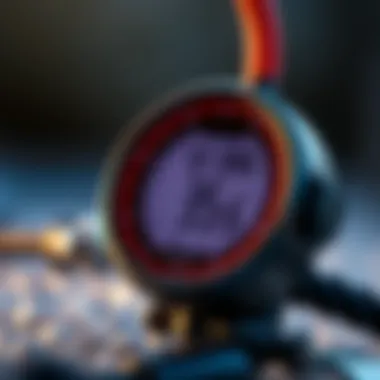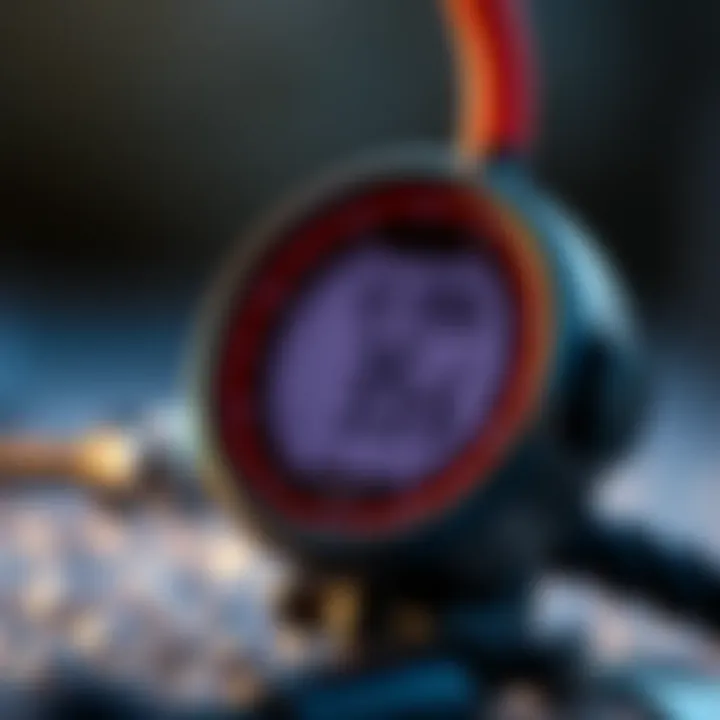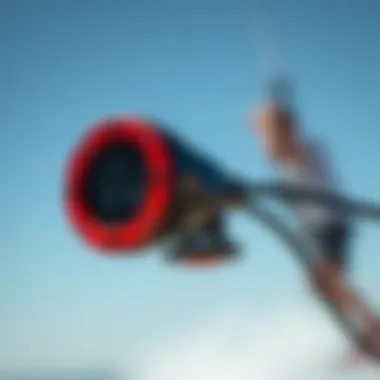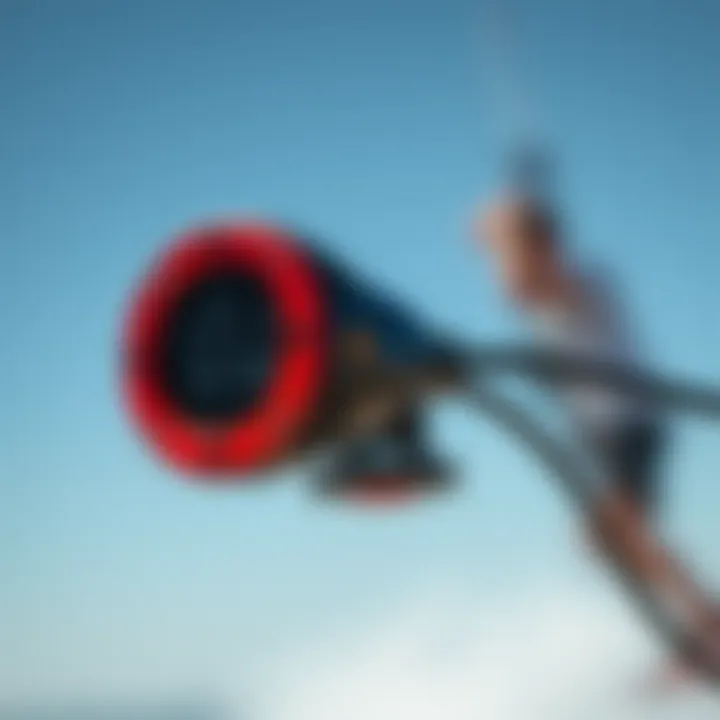Mastering Your Kiteboarding: Weather Flow Meter Guide


Intro
Kiteboarding is a sport that marries thrill with nature’s ever-changing canvas. Having the right gear is crucial, but understanding the weather plays an equally vital role. This guide focuses on the Weather Flow Weather Meter, a tool that offers kiteboarders a key advantage. It’s like having a personal meteorologist at your fingertips. With this meter, you can gauge conditions effectively and make informed decisions about when to hit the water.
Knowing the wind speed, direction, and other weather nuances can significantly impact your performance and safety. In this guide, we’ll delve into the gadget’s essential features, how to set it up, tips for optimal use, and the broader influence of weather on your kiteboarding experience. This isn’t just about gear; it’s about enhancing every session, whether you’re just starting or are a seasoned pro.
Gear and Equipment
When it comes to kiteboarding, the right gear makes all the difference. Though the Weather Flow Weather Meter is an incredible tool, it’s paramount to have a solid setup to maximize your ride.
Essential Kiteboarding Gear for Beginners
For those new to kiteboarding, breaking into the sport can be overwhelming. Firstly, you’ll need the following basics:
- Kite: Choose a kite that matches your skill level and wind conditions. Smaller kites catch less wind and are generally easier to control.
- Board: A beginner’s board should be stable and forgiving. Look for a wider board as it will help you balance better on the water.
- Harness: This connects your body with the kite, allowing for hands-free control. Opt for comfort, as you’ll be wearing it a lot.
- Safety leash: This crucial piece helps keep you tethered to your gear.
- Helmets and impact vests: These enhance safety, absorbing impacts and protecting vital areas.
Having these primary items is critical, and they set the stage for using your Weather Flow Weather Meter effectively. When you consistently check conditions—like wind speed and temperature—you can select the right gear for the day.
Advanced Equipment for Experienced Riders
As kiteboarders progress, the need for advanced equipment arises. Here’s a quick rundown of what skilled riders might consider:
- High-performance kites: These allow for better agility and control, perfect for advanced maneuvers.
- Specialized boards: Surfboards or directional boards help transform your style suited to waves or freestyle tricks.
- Custom harnesses: Tailor-made for comfort and superior support can significantly enhance performance.
- Upgraded safety systems: Features like quick-release mechanisms can be lifesavers in emergencies.
Investing in quality equipment complements the insights gained from your Weather Flow. With more advanced skills, understanding air and water conditions becomes even more crucial to push boundaries safely.
Techniques and Tips
Beyond gear, techniques and strategies play a significant role in kiteboarding success. Here, we’ll touch on necessary safety measures and training approaches to heighten your skills.
Safety Practices for Kiteboarding
Safety can never be an afterthought in kiteboarding. Even when conditions look perfect, it’s vital to take proper precautions. Here are a few:
Always be aware of local regulations regarding kiteboarding. Some areas have specific rules that can impact where and when you can ride.
- Pre-ride checks: Always inspect your gear—kites, lines, and boards—before heading out.
- Know the weather: With your Weather Flow meter, regularly assess conditions. It’s crucial to understand how changes in the weather can affect your session.
- Buddy system: Whenever possible, kite with a friend. With someone around, help is nearby should anything go awry.
- Emergency plans: Identifying safe landing zones and keeping communication devices handy can save lives.
Training Techniques to Improve Your Skills
Improving at kiteboarding requires dedication to practice and specific techniques:
- Trimming your kite: Regularly adjust the kite’s angle of attack to maintain optimal performance.
- Learning footwork: Balancing weight shift when turning enhances control.
- Progressive jumping: Start with small jumps and gradually build confidence for aerial tricks.
- Video analysis: Recording your sessions can provide valuable feedback on your technique and areas to improve.
Incorporating the Weather Flow Weather Meter usage in training sessions can lead you to recognize suitable conditions for trials and practice manoeuvers accordingly.
To wrap up, the synergy between securing appropriate equipment, adopting safety practices, and honing your skills can lead to an exhilarating kiteboarding experience. Understanding the nuances that weather brings to the sport is a game-changer. With this guide, you’re already on your way to elevating your kiteboarding adventures.
Understanding Weather Flow Weather Meter
The Weather Flow Weather Meter stands out as a vital tool in the world of kiteboarding. Being aware of weather conditions can significantly influence a kiteboarder's experience, and this device provides crucial insights. When you're out on the water, a sudden shift in wind speed can mean the difference between an exhilarating session and a perilous situation. Therefore, having an instrument that offers accurate real-time data is essential—enter the Weather Flow Weather Meter.
For kiteboarders, knowing not just the current wind conditions but also the temperature and humidity can shape strategy. The nuances of weather directly affect performance, technique, and safety. Thus, understanding how the Weather Flow Weather Meter functions and its various features can empower riders to make informed decisions, enhancing their sessions while keeping safety in the forefront.
What is the Weather Flow Weather Meter?
The Weather Flow Weather Meter is a compact, handheld device designed to collect and provide real-time weather data. At first glance, it may resemble a simple gadget, but don’t let its size fool you. This meter is equipped with advanced sensors that gather information about wind speed, temperature, and humidity, making it an indispensable companion for anyone on a kiteboard. Users appreciate its ease of use; just a few button presses and you get the weather data you need. It's like having a portable meteorologist right in your pocket!
How Weather Flow Technology Works
The heart of the Weather Flow Weather Meter lies in its sophisticated technology. This device utilizes an array of sensors, each calibrated to measure specific environmental variables.
- Wind Sensors: These measure the speed and direction of the wind, which is crucial for evaluating whether conditions are suitable for kiteboarding.
- Temperature Sensors: They gauge the ambient temperature, another factor that can impact both rider comfort and equipment performance.
- Humidity Sensors: Humidity readings help in assessing how the air's moisture can affect flight and control.
This data is collected and processed in real-time, providing immediate feedback to the user. So whether you’re at the beach, on the waves, or planning your next session, you'll always have relevant weather updates right at your fingertips.
Key Features of the Device
Real-time Wind Data


Real-time wind data is the star feature of the Weather Flow Weather Meter. Kiteboarders can access immediate readings of wind speed and direction, allowing for tailored decision-making. The real-time aspect means that riders aren't just getting stale data; they receive updated readings on the fly. This timely information helps to avoid dangerous situations, especially when conditions change suddenly. Riders love how it allows them to scout the perfect kicks and jumps seamlessly, giving them an edge during their sessions.
Temperature and Humidity Sensors
Temperature and humidity sensors play a pivotal role as well. The temperature readings inform riders about their gear choices. After all, freezing temperatures can be uncomfortable, affecting performance. Similarly, humidity impacts the air's buoyancy, which can alter kite response. The Weather Flow Weather Meter's capability to monitor these factors allows riders to adapt quickly, ensuring that their experience remains optimal no matter what Mother Nature has in store. Having this dual data at their avail makes riders feel much more prepared and efficient out there.
Compact Design
The compact design of the Weather Flow Weather Meter cannot be understated. It’s lightweight and easily portable, allowing it to travel with you without adding bulk. This portability means that kiteboarders can carry it in their packs, ensuring that weather conditions are always at hand. Many users appreciate how it fits snugly in their palm, lending itself to hassle-free operation. Whether it’s to the beach or while hiking to a prime spot, this design suits active lifestyles perfectly, making constant weather monitoring a breeze.
Installation and Setup
Getting the Weather Flow Weather Meter up and running correctly is a key first step in enhancing your kiteboarding experience. This process isn’t just about plugging in a device; it’s about crafting the foundation for more informed and safer rides. When you ensure your meter is set up right, you can count on accurate readings and reliable performance, which can make or break a day out on the water.
Unboxing the Weather Meter
Upon receiving your Weather Flow Weather Meter, the first action is to hop into the excitement of unboxing it. The package typically contains the weather meter itself, a quick start guide, and a few mounting accessories. Inspect everything closely; it’s worth taking an extra moment to ensure all parts made the journey unscathed.
The initial thrill of touching the hardware should be balanced with a bit of caution. Make sure to read through the quick start guide first—it lays out the basics in a clear manner. You want to feel confident that every piece has its place and purpose.
- Ensure no parts are missing: Double-check against the contents listed in the user manual.
- Familiarize yourself with components: Knowing each part helps simplify the subsequent setup processes.
Mounting Options for Optimal Performance
Mounting your Weather Flow device is about more than just sticking it somewhere convenient. The placement will directly affect the accuracy of the data you receive. Here are some effective options to ensure optimal positioning:
- Fix it at a High Point: Ideally, you want to mount the meter at a height where wind flows freely—this could be on a high fence, a mast, or any other sturdy fixture close to the kiteboarding area.
- Pay Attention to the Environment: Avoid placing it near large structures, trees, or obstacles that can interfere with wind flow. A clear sightline to the open sky enables the meter to measure conditions accurately.
- Experiment with Angles: When it's safe to do so, try adjusting the tilt and angle of the meter to see if that offers better data capture.
"The key to a successful installation is ensuring your device isn't just anchored, but secured in the most effective position for wind measurement."
Connecting to Mobile Applications
After you've the Weather Flow Weather Meter mounted, the next step involves connecting it to your mobile device. This integration is where the magic happens—it taps into the software's power to interpret the data efficiently. Here's a straightforward approach to set it up:
- Download the App: Head over to the App Store or Google Play and download the Weather Flow app. It's like having a personal weather assistant in your pocket.
- Bluetooth Connection: Once the app is installed, enable Bluetooth on your mobile device. Open the app and follow the on-screen instructions to connect to the Weather Meter. The app should recognize your device almost instantly.
- Grant Permissions: Ensure you allow the necessary permissions for the app to access location data and notifications. These permissions enhance functionality and accuracy.
Understanding how to seamlessly connect your meter to your mobile device is crucial. It’s the linchpin in creating a fluid exchange of real-time data, enabling on-the-fly adjustments during your kiteboarding sessions.
Using the Weather Flow Weather Meter
Utilizing the Weather Flow Weather Meter is crucial for kiteboarders aiming to optimize their riding experiences. By understanding and effectively using this gadget, enthusiasts can accurately assess weather conditions, which directly influences safety and performance on the water. Mother Nature can be fickle; knowing when to hit the waves and when to stay on shore can mean the difference between a thrilling ride and a dangerous mishap.
Understanding Readings and Data Interpretation
Getting the hang of your Weather Flow Weather Meter readings is foundational. The device provides real-time data on wind speed, direction, temperature, and humidity—each playing a pivotal role in kiteboarding activities. For instance, wind speed measured in miles per hour (MPH) or knots (kn) tells you if the wind is suitable for your chosen gear. Typically, a sustained wind of 12 to 25 knots is ideal for most kiteboarders, depending on their skill level and kite size.
When interpreting wind direction, look for the arrows on your meter or app, as they indicate where the wind is blowing from. This knowledge helps in choosing the right launch spots. A common phrase among kiteboarders is, "Know the wind, know your ride." If you understand the readings and make sense of the numbers, you can predict your performance trail for the day.
Accessing Historical Data for Insights
Historical data from the Weather Flow Weather Meter is a goldmine for kiteboarders. Capturing past weather conditions allows you to identify patterns in wind behavior over time. For example, accessing previous trends can reveal peak wind days during certain seasons or recognized shifts that might indicate changing weather patterns.
Here’s a practical approach to using this data:
- Review past days: Check the historical logs of wind speed, direction, and temperature.
- Create a riding calendar: Mark days with favorable conditions from your records.
- Stay ahead of the game: Use insights from prior conditions to plan future outings.
By analyzing historical weather data, you can develop a keen sense of when and where to ride—essentially making informed decisions that lead to more enjoyable kiteboarding sessions.
Integrating Weather Data into Kiteboarding Strategies
Integrating the data gathered from your Weather Flow Weather Meter into your kiteboarding strategies is where the real magic happens. Understanding weather insights helps in planning your riding days effectively. For instance, if you notice that certain wind conditions yield the best experiences with your kit, you can adjust your outings to match those conditions.
Here are some strategies to keep in mind:
- Select the right gear: Match your kite’s size with the wind conditions. Lighter winds require larger kites, while stronger winds benefit from smaller kites.
- Choose the right time: Plan your session during peak wind times indicated in your historical data, enhancing your chances of having a thrilling ride.
- Assess location suitability: Choose launch sites that provide favorable wind patterns, avoiding areas known for rapid changes or gusts.
By weaving together this weather data and kiteboarding practices, you can create a tailored and more effective ride experience that leaves little room for uncertainty.
Impact of Weather Conditions on Kiteboarding
Understanding how weather conditions affect kiteboarding is crucial for anyone who wants to enjoy this exhilarating sport to its fullest. Whether you are a seasoned veteran or just starting your journey, having a keen awareness of weather influences can be the difference between an unforgettable experience and a dangerous situation. Here, we delve into the pivotal elements that you need to understand in order to navigate your kiteboarding sessions safely and effectively.


Assessing Wind Conditions: Safe Limits
Wind conditions are at the heart of kiteboarding; they dictate everything from the type of kite you should use to your ability to thrive on the water. Most kites perform best within certain wind ranges, and being aware of these limits can safeguard you from peril.
It's essential to know that kiteboarding in high winds can be thrillin’ but also risky. Typically, a good wind speed for beginners falls between 10 to 20 knots. Over 20 knots can lead to dangerous gusts, which may make controlling your kite a challenge. You don’t want to get caught in a situation where it’s like trying to steer a bus in a tornado!
Monitoring wind conditions with tools such as the Weather Flow Weather Meter can provide an accurate real-time assessment. By checking the data, riders can avoid unsuitable wind conditions and make informed decisions about when to hit the water.
"Good judgement comes from experience, and experience comes from bad judgement."
Effects of Temperature and Humidity on Performance
Temperature and humidity might not seem as pressing as wind, but they play a significant role in kiteboarding. Warm weather typically leads to lighter winds, which could be perfect for novice kiteboarders. However, as you advance, you might prefer the more aggressive gusts found on cooler days. A general rule of thumb is that for every 10 degrees Fahrenheit increase in temperature, the wind speed typically decreases by about 1 to 2 knots.
Humidity affects not just the comfort level but also how the kite handles in varying conditions. High humidity can make it feel much windier than it is, possibly prompting overestimation of wind conditions, leading to unsafe decisions. Being aware of how temperature and humidity can distort your perceptions is vital for achieving optimal performance.
Recognizing Weather Patterns and Predicting Changes
Understanding weather patterns allows kiteboarders to anticipate changing conditions. Not every day out on the water will be idyllic; sometimes, clouds roll in, or a storm brews unexpectedly. Learning to read the sky is an invaluable skill for kiteboarders. Take the time to familiarize yourself with signs such as sudden temperature drops, increased cloud cover, or shifts in wind direction, which may indicate incoming weather changes.
Using local weather forecasts, real-time data from devices like the Weather Flow Weather Meter, and apps designed for kiteboarders can aid you in predicting shifts in weather patterns. This proactive approach not only enhances your riding experience but also keeps you safe while out on the water.
Stay informed, stay safe, and most importantly, have fun!
Comparing Weather Flow Weather Meter with Other Tools
When it comes to kiteboarding, understanding the weather can be the difference between an awesome day on the water and a less-than-ideal experience. This section illuminates the significance of the Weather Flow Weather Meter by putting it side by side with other tools available in the market. The differences can help you make strategic choices that optimize your kiteboarding performance, ensuring safety and enjoyment.
Traditional Weather Tools Versus Digital Solutions
In the realm of weather measurement, traditional tools like anemometers and barometers have held the fort for a long time. They provide readings through simple mechanical means, often requiring manual observations and calculations. These instruments can be reliable but come with drawbacks. They may offer less precision and can sometimes be cumbersome to use.
On the flip side, digital solutions such as the Weather Flow Weather Meter bring a modern flair to the table. With real-time data capabilities, they can connect to mobile devices and apps, allowing users to access a wealth of information at their fingertips.
The convenience factor here is tremendous. No more squinting at tiny dials or translating complex readouts. Instead of manually recording data, a digital meter will store and analyze the information automatically. The ability to measure wind speed, temperature, and humidity simultaneously presents a more holistic view of weather conditions, which is particularly useful for kiteboarders trying to gauge the best practice conditions.
Cost Analysis of Various Weather Measurement Devices
Cost can often be a sticking point when it comes to purchasing weather measurement tools. The Weather Flow Weather Meter is relatively affordable compared to high-end alternatives. It can cost somewhere in the range of $100 to $150, which might seem hefty initially but pales in comparison to other sophisticated weather solutions.
For instance, more advanced setups that feature complete weather stations, including multiple sensors and computer interfaces, can easily run into the thousands of dollars. This begs the question: how much do you really need? For recreational kiteboarders, investing in an all-in-one device like the Weather Flow is a no-brainer.
Cost breakdown:
- Weather Flow Weather Meter: Approx. $100 - $150
- Traditional Anemometer: Approx. $30 - $80
- Full Weather Station Kits: Starting from $500 and can go up to $2000+
It's crucial to weigh the cost against the benefits, considering not only the features but also the value of improved safety and performance on the water.
User Experiences: Feedback and Reviews
User feedback is a goldmine for potential buyers considering the Weather Flow Weather Meter. Online reviews often reveal two very distinct experiences. Many users rave about the device's accuracy and ease of use, while others might mention occasional connectivity issues with their smartphones, which is not uncommon with Bluetooth devices.
Some kiteboarders have even shared glowing anecdotes about how real-time data gave them the foresight to maximize their sessions or avoid sudden storms. This highlights a key benefit of the device—a solid blend of technology that can significantly influence your kiteboarding experience.
"The Weather Flow Weather Meter saved me from a nasty surprise last weekend. Caught wind shifts just in time to pack up before the storm rolled in!"
The emphasis on community feedback can provide a broader picture, especially when forums are threaded with stories from fellow kiteboarders. Resources like Reddit and specialized kiteboarding forums can be treasure troves where users share their experiences and offer valuable tips one wouldn’t easily find elsewhere.
In summary, comparing the Weather Flow Weather Meter with traditional tools and other digital devices gives kiteboarders a clearer picture of what to expect. The combination of affordability, convenience, and community feedback solidly propels this device to the forefront for anyone serious about optimizing their kiteboarding. This insight can help you choose not just a tool, but an essential part of your kiteboarding arsenal.
Advanced Techniques for Experienced Riders
For kiteboarders who have honed their skills and want to elevate their riding experience, understanding advanced techniques is crucial. This section focuses on several methods and insights that can help seasoned riders maximize their time on the water. By employing these techniques, they're not just improving their individual performance; they're also paving the way for safer and more enjoyable sessions that consider changing weather conditions and local wind patterns.
Using Wind Maps for Enhanced Planning
Wind maps are invaluable tools for kiteboarders looking to optimize their sessions. Unlike static forecasts, these maps provide a detailed visualization of wind conditions across diverse locations. Riders can access wind data from various platforms like Windy or Windfinder.
- Real-time Updates: Wind maps often include real-time variables that help users to swiftly adapt to changing conditions. This feature is especially useful for experienced riders who plan their sessions around specific wind speeds and directions.
- Identifying Hotspots: Over time, understanding local wind patterns can lead riders to discover hidden spots that may not be as crowded, often leading to a significantly enhanced experience.
- Strategy Development: By using wind maps, advanced kiteboarders can tailor their session strategies, whether it be jumping, freestyle, or long-distance rides.
Experienced riders know that staying ahead of the wind is half the battle; hence, making wind maps a regular part of your preparatory process is key.


Analyzing Localized Wind Effects
Every kiteboarder knows that the wind is not always uniform. Localized wind effects can drastically change how and where one should ride. Understanding phenomena such as thermal winds, sea breezes, and obstacles like buildings or natural formations can significantly enhance your performance.
- Thermal Winds: These are common during warm sunny days and can create strong wind pockets. It's essential for an experienced rider to recognize when to take advantage of these conditions.
- Ground Effect: Being aware of how nearby structures or terrain influence the wind's path helps riders avoid turbulence and find areas of smoother sailing.
- Microclimates: Certain areas might experience radically different conditions due to variations in geography. This can mean drastically different wind strengths a few hundred feet apart.
By being diligent in analyzing localized conditions, riders can navigate safely and avoid unexpected challenges on the water.
Adjusting Techniques Based on Real-time Data
The real-time data provided by the Weather Flow Weather Meter is more than just numbers; it’s a live insight into the wind's behavior. Experienced riders can leverage this information to refine their techniques and maneuvers in response to current conditions.
- Dynamic Adjustments: Real-time feedback allows for on-the-fly adjustments. If wind speeds increase or decrease significantly mid-session, adapting one's ride can mean the difference between a smooth glide and a chaotic tumble.
- Optimized Jump Techniques: High winds can afford higher jumps, while lower winds might necessitate a focus on keeping the board level with the water. Knowing how to adjust techniques accordingly can enhance both performance and safety.
- Tactical Riding: Depending on wind shifts displayed on real-time data, advanced riders can decide whether to attempt challenging tricks or opt for more conservative maneuvers.
"Understanding your environment and adjusting your riding technique accordingly can often turn an average session into something exceptional."
Fostering a habit of realizing and adapting to changing conditions, based on what the weather meter indicates, is a mark of a truly skilled kiteboarder.
By integrating these advanced techniques into their practices, experienced kiteboarders can dramatically enhance their riding adventures. Whether it's making sense of a complex wind map, compensating for localized effects, or adjusting maneuvers mid-session, every informed decision builds toward a more enjoyable and fulfilling kiteboarding experience.
Safety Considerations in Kiteboarding
Kiteboarding is an exhilarating sport that meshes thrill with skill, but with excitement comes a certain level of risk. Therefore, focusing on safety considerations is paramount not just for enjoyment but also to safeguard the well-being of all involved. Many factors contribute to a safe kiteboarding experience, and understanding these can make a significant difference.
Importance of Weather Awareness
Weather plays a pivotal role in kiteboarding safety. Not only does it dictate the perfect conditions for a ride, but adverse weather can swiftly escalate into dangerous scenarios.
Emphasizing the necessity for weather awareness, riders must be mindful of changing conditions that could impact their session drastically. Before even stepping onto the water, checking the forecast is vital. Wind speeds should ideally fall within the safe range that the rider is comfortable with. As the old saying goes, “it takes just a gust of wind to turn pleasure into peril.”
Here are some points to consider regarding weather awareness:
- Consistently monitoring wind speed and direction using reliable tools like the Weather Flow Weather Meter can guide decisions on when to ride and when to stay put.
- Understanding local microclimates can help anticipate sudden weather shifts, as conditions can differ dramatically from one area to another.
- Recognizing signs of deteriorating weather, such as dark clouds or sudden drops in temperature, is crucial for safety.
Emergency Protocols in Changing Conditions
Even with the best plans, nature can be unpredictable. A well-prepared kiteboarder should have emergency protocols in place to respond effectively in unexpected situations.
Consider developing a plan that includes the following protocols:
- Know your nearest safe landing zones. Find out where you can quickly land your kite safely, whether it’s a beach or a grassy area.
- Have a communication plan. Equip yourself with a reliable means of staying in contact with friends or fellow riders. When things go sideways, having someone to assist you is a lifesaver.
- Practice self-rescue techniques. Understanding how to self-rescue when the wind picks up or when equipment fails is vital. Regular practice of these techniques should be part of every kiteboarder’s regimen.
- Keep an emergency kit. Basic supplies such as a first aid kit, signaling devices, and extra buoyancy aids can make a significant difference in emergencies.
"Preparedness is the essence of survival. Don’t let a moment of thrill turn into a lifetime of regret."
Gear Recommendations Based on Weather Insights
Choosing the right gear based on weather conditions is an art that every kiteboarder should master. Not all kites suit every wind condition, and having appropriate gear can be a game-changer for safety and performance.
Some recommendations include:
- Kite Size: Opting for a larger kite in lighter winds and a smaller kite in higher winds is essential. Understanding this balance can dramatically reduce risks.
- Harness Selection: Using a comfortable yet secure harness that fits well can lessen fatigue and increase control. Check for designs that offer good support without compromising on mobility.
- Wearable Safety Devices: Incorporating devices such as personal flotation devices and helmets should not be an afterthought; they can help mitigate the consequences of accidents.
- Footwear: Choosing the right foot protection can also impact performance and safety. Consider wearing water shoes designed for grip and protection against sharp objects.
In summary, prioritizing safety in kiteboarding is not just about following guidelines but about actively engaging with the environment and adapting to its conditions. Just remember, it’s better to be safe than sorry!
Future Trends in Weather Measurement Technology
In the evolving landscape of kiteboarding, understanding how weather measurement technology is advancing is crucial for enthusiasts and experienced riders alike. The increasing reliance on precise weather data enhances kiteboarding experiences significantly by allowing riders to make informed decisions about when and where to hit the water. A pivotal instrument in this realm is the Weather Flow Weather Meter, which is continuously influenced by emerging trends that shape its capabilities.
Emerging Innovations in Weather Devices
The next generation of weather devices is pushing beyond the conventional limits we might be familiar with. From integrating accessibility features into apps to harnessing the power of micro-sensors that provide hyper-localized data, innovations are flowing at a rapid pace. For example, compact weather sensors combined with smartphone connectivity allow users to receive real-time updates while basking in their kiteboarding adventures. These innovations not only improve the accuracy of weather readings but also expand users' horizons regarding their kiteboarding options.
Moreover, devices incorporating solar-powered technology can offer extended use in environments where battery life might be a concern. Users are becoming increasingly empowered, able to rely on lightweight yet sophisticated gadgets that adhere to the unique demands of outdoor sports, adapting to diverse weather scenarios effortlessly.
The Role of Artificial Intelligence in Weather Prediction
Artificial intelligence is undoubtedly reshaping how we interpret weather data. Advanced algorithms analyze historical weather patterns, collating vast amounts of data to forecast conditions more reliably and accurately. For kiteboarders, this tool ensures that the most optimal conditions can be anticipated rather than just reacted to. AI models can learn from previous weather events, identifying patterns that help predict changes much before they occur.
Furthermore, when integrated with devices like the Weather Flow Weather Meter, AI can offer personalized forecasts, honing in on specific locales based on previous kiteboarding outings. This provides the necessary edge to plan sessions when conditions are just right— a crucial factor in enjoying the sport safely.
Integration with Other Sports Technologies
The future is also leaning towards a confluence of sports technologies, where devices connect and communicate to create a seamless experience for users. Think of wearable fitness trackers that not only calculate kiteboarding metrics but also relay information back to the Weather Flow Meter.
This integration could offer kiteboarders comprehensive data on their performance relative to current environmental conditions. Also, cloud-based platforms are emerging to aggregate weather data from multiple devices across various sports, thus providing a holistic view that can enhance strategic planning for activities beyond just kiteboarding.
The synergy between weather measurement devices and sports technologies depicts a future where tailored experiences become increasingly attainable.



